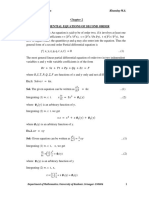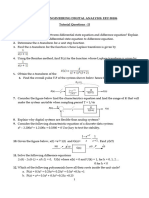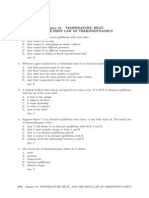Assignment Admath PDE
Uploaded by
Green CrossAssignment Admath PDE
Uploaded by
Green Cross2 2
∂ u ∂ u
First Oder PDE- 2
+ 2 =0
∂x ∂y
∂z ∂z ∂z
Linear PDE – x +y +t =xyt
∂x ∂ y ∂t
dx dy dt dz
= = =
x y t xyt
x t
u= =a , v= =b
y y
x ( yt ) + y ( xt )+ t ( xy ) + ( xyt )(−3 )=0 ,
yt dx+ xt dy + xy dt−3 dz=0∧¿
xyt−3 z=c
ϕ ( xy , ty , xyt−3 z)=0
Quasilinear PDE - z= p2 +q 2
z=F ( x +ay )=F ( u )
dz dz
p= , q=a
du du
( ) ( )
2 2
dz 2 dz
z= +a
du du
= √ 2∨ =
dz z dz 1
du
du √1+ a √ z √1+a 2
1 1
2 √z= u +k = (u+ b )
√ 1+a 2
√ 1+a2
4 ( 1+a2 ) z=( x +ay +b )
2
Homogenous PDE –
dy
dx ()
=F ( x , y ) =g
y
x
Step 1- Substitute y = vx in the given differential equation.
Step 2 – Differentiating, we get,
dy dv
=v + x
dx dx
. Now substitute the value of and y in the given differential equation, we get
dv dv
v+ x =g ( v )−−−→ x =g ( v )−v
dx dx
Step 3 – Separating the variables, we get.
dv dx
=
g ( v )−v x
Step 4 – Integrating both side of equation, we have
dv dx
∫ g ( v )−v dv =∫ x
+c
Step 5 – After integration we replace v=y/x
You might also like
- Module 4 - Partial Differential EquationsNo ratings yetModule 4 - Partial Differential Equations8 pages
- Unit-Ii: Partial Differential Equations-I: X y Yy XX XyNo ratings yetUnit-Ii: Partial Differential Equations-I: X y Yy XX Xy16 pages
- Module 3 - Partial Differential Equations Part 1 - PPT. 16888102435516No ratings yetModule 3 - Partial Differential Equations Part 1 - PPT. 1688810243551633 pages
- UE22MA141A_40c31e4e-2ce4-11ed-893d-0a940780a7b0_20230118103607 (1)No ratings yetUE22MA141A_40c31e4e-2ce4-11ed-893d-0a940780a7b0_20230118103607 (1)27 pages
- Unit - Iii Partial Differential Equation: ϕ (x,y,z,a,b) =0 →No ratings yetUnit - Iii Partial Differential Equation: ϕ (x,y,z,a,b) =0 →6 pages
- Rejinpaul TPDE Formula/unit i-PDE - RejinpaulNo ratings yetRejinpaul TPDE Formula/unit i-PDE - Rejinpaul5 pages
- Unit - Iii Partial Differential Equation: ϕ (x,y,z,a,b) =0 →No ratings yetUnit - Iii Partial Differential Equation: ϕ (x,y,z,a,b) =0 →22 pages
- MA3351-TRANSORMS AND PARTIAL DIFFERENTIAL EQUATIONS- By www.notesfree.inNo ratings yetMA3351-TRANSORMS AND PARTIAL DIFFERENTIAL EQUATIONS- By www.notesfree.in160 pages
- Course Handout MAT 201: Partial Differential Equations and Complex Analysis Module 1: Partial Differential EquationsNo ratings yetCourse Handout MAT 201: Partial Differential Equations and Complex Analysis Module 1: Partial Differential Equations37 pages
- Ma 201: Lecture - 3 Solving Quasilinear PdesNo ratings yetMa 201: Lecture - 3 Solving Quasilinear Pdes30 pages
- Differential Equations & Transforms (BMAT102L)No ratings yetDifferential Equations & Transforms (BMAT102L)19 pages
- 3140610_CVPDE_GTU_Study_Material_e-Notes_Unit---4_25012021084133AMNo ratings yet3140610_CVPDE_GTU_Study_Material_e-Notes_Unit---4_25012021084133AM8 pages
- E-Notes_3891_Content_Document_20250113104813AMNo ratings yetE-Notes_3891_Content_Document_20250113104813AM50 pages
- Ma6351-Tpde - Anna University Important Two MarksNo ratings yetMa6351-Tpde - Anna University Important Two Marks49 pages
- II Sem - Module 4 - Partial Diferential Equations - NotesNo ratings yetII Sem - Module 4 - Partial Diferential Equations - Notes17 pages
- Module - 3 Partial Differential EquationsNo ratings yetModule - 3 Partial Differential Equations23 pages
- Mathematics 1St First Order Linear Differential Equations 2Nd Second Order Linear Differential Equations Laplace Fourier Bessel MathematicsFrom EverandMathematics 1St First Order Linear Differential Equations 2Nd Second Order Linear Differential Equations Laplace Fourier Bessel MathematicsNo ratings yet
- Btech 1 Sem Engineering Mathematics 1 Nas103 2022No ratings yetBtech 1 Sem Engineering Mathematics 1 Nas103 20222 pages
- Bmat102l Differential-equations-And-transforms TH 1.0 65 Bmat102lNo ratings yetBmat102l Differential-equations-And-transforms TH 1.0 65 Bmat102l3 pages
- Problem Set 12 Key - Physical Chemistry For Engineers (Book Work)No ratings yetProblem Set 12 Key - Physical Chemistry For Engineers (Book Work)6 pages
- 04 Solution Thermo (Topic 2 Part 1) - 20232No ratings yet04 Solution Thermo (Topic 2 Part 1) - 2023233 pages
- Stress-Energy Pseudotensors and Gravitational Radiation PowerNo ratings yetStress-Energy Pseudotensors and Gravitational Radiation Power8 pages
- For You to Do 1. In an area free of obstacles, stretch out a Slinky® so the turns are a few Centimeters apart. Mark the positions of the end of the Slinky by sticking pieces of Tape on the floor. Measure the distance between the pieces of tape. a) Record the distance between the pieces of tape in your log. 2. With the Slinky stretched out to the tape, grab the spring near one end, as Shown in the drawing, and pull sideways 20 cm and back. To move it correctly,No ratings yetFor You to Do 1. In an area free of obstacles, stretch out a Slinky® so the turns are a few Centimeters apart. Mark the positions of the end of the Slinky by sticking pieces of Tape on the floor. Measure the distance between the pieces of tape. a) Record the distance between the pieces of tape in your log. 2. With the Slinky stretched out to the tape, grab the spring near one end, as Shown in the drawing, and pull sideways 20 cm and back. To move it correctly,4 pages
- Chapter 2 Direct Methods For Solving Linear SystemsNo ratings yetChapter 2 Direct Methods For Solving Linear Systems75 pages
- What's Important: Time-Independent Schrödinger EquationNo ratings yetWhat's Important: Time-Independent Schrödinger Equation5 pages
- Fourier's Law and The Heat Equation: Chapter TwoNo ratings yetFourier's Law and The Heat Equation: Chapter Two16 pages
- HTTPS://WWW Sanrio Com/collections/hello-Kitty?srsltid AfmBOopt3dJUOg78TTsikMAQrcxjhVuKTElMMxDJkXYc-iLSXBGwDvjwNo ratings yetHTTPS://WWW Sanrio Com/collections/hello-Kitty?srsltid AfmBOopt3dJUOg78TTsikMAQrcxjhVuKTElMMxDJkXYc-iLSXBGwDvjw1 page
- Chapter 19: TEMPERATURE, HEAT, and The First Law of ThermodynamicsNo ratings yetChapter 19: TEMPERATURE, HEAT, and The First Law of Thermodynamics18 pages
- 2.1 To 2.3 Functions of Several Variables and Partial DerivativesNo ratings yet2.1 To 2.3 Functions of Several Variables and Partial Derivatives43 pages
























































































